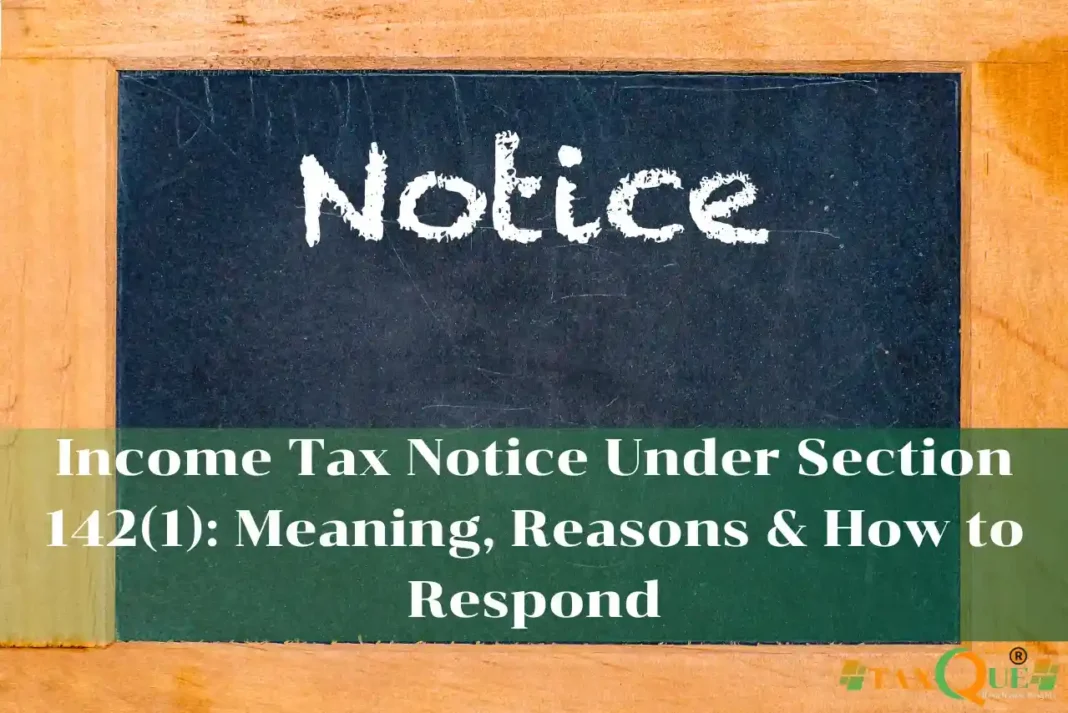Introduction
Receiving an Income Tax Notice Under Section 142(1) from the Income Tax Department can feel overwhelming, but it’s often just a request for clarification or additional information. Issued under the Income Tax Act, 1961, this notice is part of the preliminary inquiry process before a tax assessment. Understanding what an Income Tax Notice Under Section 142(1) means, why it’s issued, and how to respond can help you stay compliant and avoid penalties. This guide covers the notice’s purpose, common reasons, response process, and tips to handle it effectively. Let’s dive in to make the process stress-free!
What is an Income Tax Notice Under Section 142(1)?
An Income Tax Notice Under Section 142(1) is issued by the Assessing Officer (AO) to gather information from a taxpayer. As per the Income Tax Department (https://incometaxindia.gov.in), Section 142(1) empowers the AO to:
- Request taxpayers to file their Income Tax Return (ITR) if not filed for a specific assessment year.
- Ask for additional documents or information to verify an already filed ITR.
- Seek clarification for discrepancies or inconsistencies in the return.
This notice is typically issued before a detailed scrutiny assessment, ensuring the AO has all necessary details to evaluate your tax liability accurately.
Common Reasons for Receiving an Income Tax Notice Under Section 142(1)
The Income Tax Department may issue an Income Tax Notice Under Section 142(1) for several reasons, including:
- Non-Filing of ITR: You haven’t filed your ITR for a particular assessment year, despite taxable income.
- Verification Needs: The AO requires additional documents to verify income, deductions, or credits claimed in your ITR.
- Mismatches: Discrepancies between your ITR and data like Form 26AS (TDS details) or high-value transactions reported in the Annual Information Statement (AIS).
- High-Value Claims: Large deductions, exemptions, or transactions (e.g., property sales) that need justification.
- Scrutiny Selection: Your ITR is selected for scrutiny under Section 143(2) for a detailed review.
Understanding the reason is key to responding correctly and avoiding further issues.
Contents of an Income Tax Notice Under Section 142(1)
The notice typically includes the following details:
| Component | Description |
|---|---|
| PAN and Assessment Year | Your Permanent Account Number and the relevant tax year. |
| Reason for Notice | Why the notice was issued (e.g., non-filing, verification, or discrepancies). |
| Requested Documents | List of documents or information required (e.g., bank statements, sale deeds). |
| Response Deadline | Date by which you must submit the response (usually 15–30 days). |
Carefully review the notice to understand the AO’s requirements.
How to Respond to an Income Tax Notice Under Section 142(1)
Responding to an Income Tax Notice Under Section 142(1) is straightforward with the e-Filing portal. Follow these steps:
- Log In to e-Filing Portal: Visit https://www.incometax.gov.in and log in using your PAN and password.
- Access e-Proceedings: Navigate to the “e-Proceedings” tab under the dashboard.
- Select the Notice: Find the Section 142(1) notice for the relevant assessment year and click “Submit Response.”
- Upload Documents: Provide the requested documents (e.g., ITR, bank statements, proofs) in PDF format or enter explanations as needed.
- Submit and Save: Review your response, submit it, and download the acknowledgment for your records.
Timely submission is critical to avoid complications.
Consequences of Ignoring the Notice
Failing to respond to an Income Tax Notice Under Section 142(1) can lead to serious consequences:
- Best Judgment Assessment (Section 144): The AO may estimate your income and tax liability, potentially leading to higher taxes.
- Penalties and Interest: You may face penalties under Section 271(1)(b) (₹10,000 per failure) and interest on unpaid taxes under Section 234A/B/C.
- Prosecution: Willful default in extreme cases may lead to legal action under the Income Tax Act.
The Central Board of Direct Taxes (https://www.cbic.gov.in) emphasizes timely compliance to avoid such outcomes.
Tips for Handling an Income Tax Notice Under Section 142(1)
Here are practical tips to manage the notice effectively:
- Act Promptly: Respond within the deadline (usually 15–30 days) to avoid penalties.
- Organize Documents: Keep ITRs, bank statements, Form 16/26AS, and other proofs ready.
- Seek Expert Help: Consult a chartered accountant or tax professional if the notice is complex.
- Maintain Records: Save copies of your response and acknowledgment for future reference.
- Check AIS/Form 26AS: Verify mismatches in high-value transactions or TDS before responding.
Handling an Income Tax Notice Under Section 142(1) can be daunting, especially for first-timers. TaxQue simplifies the process by offering expert guidance on notice responses, document preparation, and tax compliance. With tailored support for ITR filing and notice handling, TaxQue ensures you respond accurately and on time, making it an ideal tool for taxpayers.
Frequently Asked Questions (FAQs)
1. What is an Income Tax Notice Under Section 142(1)?
An Income Tax Notice Under Section 142(1) is issued by the Assessing Officer to request an ITR filing, additional documents, or clarification of discrepancies in a filed return.
2. Why did I receive an Income Tax Notice Under Section 142(1)?
Common reasons include not filing your ITR, discrepancies in income/TDS, high-value transactions, or selection for scrutiny assessment.
3. How do I respond to an Income Tax Notice Under Section 142(1)?
Log in to https://www.incometax.gov.in, go to “e-Proceedings,” select the notice, upload requested documents or explanations, and submit your response.
4. What happens if I ignore the notice?
Ignoring the notice may lead to a best judgment assessment (Section 144), penalties (₹10,000 per failure), interest on unpaid taxes, or prosecution in extreme cases.
5. Can I seek professional help to respond to the notice?
Yes, consulting a chartered accountant or using a platform like TaxQue can help you prepare accurate responses and ensure compliance.
Conclusion
An Income Tax Notice Under Section 142(1) is not a penalty but a request for information to ensure accurate tax assessment. By understanding its purpose, responding promptly, and providing the required documents, you can resolve the notice smoothly and avoid penalties. Tools like TaxQue make the process easier with expert support for compliance and notice handling. Don’t let the notice stress you out—visit https://www.incometax.gov.in today to check your notices and respond on time to stay compliant!





